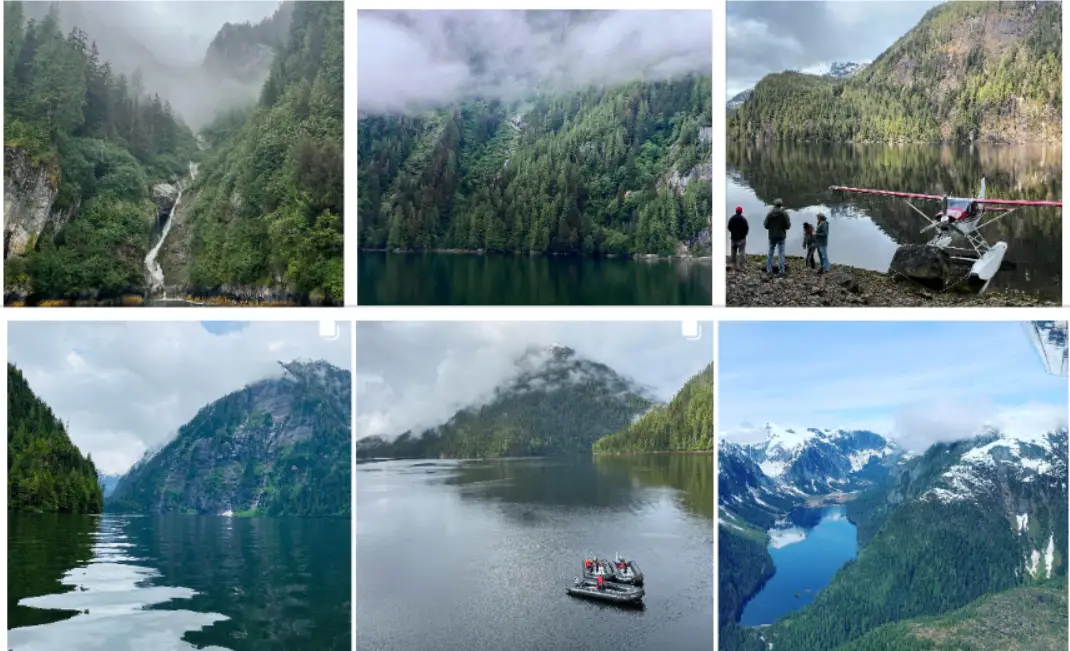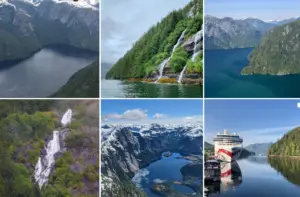Misty Fjords National Monument : Interesting Facts, History & Travel Guide

- By
- Aparna Patel
- |
- 12 Apr, 2023
- |

Welcome to our guide to Misty Fjords National Monument, a breathtaking wilderness area located in southeastern Alaska. This remote and pristine landscape is home to towering fjords, crystal-clear lakes, and ancient forests that have been shaped by millions of years of glacial activity.
In this blog, we will delve into the interesting facts and history of Misty Fjords, as well as provide a comprehensive travel guide to help you plan your visit to this incredible destination. Whether you’re an outdoor enthusiast, a wildlife lover, or simply looking for a peaceful escape, Misty Fjords has something to offer everyone. So, grab your hiking boots and rain gear, and let’s explore Misty Fjords National Monument together.
Table of Contents
Interesting facts about Misty Fjords National Monument
- Misty Fjords National Monument is located in the Tongass National Forest in Alaska, covering an area of over 2.3 million acres.
- The monument is named after the mist that often shrouds the area’s deep fjords and rugged coastal mountains, creating a mystical and otherworldly atmosphere.
- Misty Fjords is home to several Native Alaskan tribes, including the Tlingit, Haida, and Tsimshian, who have lived in the area for thousands of years and still maintain strong cultural ties to the land.
- The monument is known for its spectacular natural beauty, with steep granite cliffs, deep blue fjords, cascading waterfalls, and abundant wildlife, including bears, wolves, moose, and bald eagles.
- Misty Fjords is a popular destination for outdoor enthusiasts, with opportunities for hiking, fishing, kayaking, and wildlife watching.
- The monument was established by President Jimmy Carter in 1978 under the Antiquities Act, which allows the president to protect unique natural or cultural resources on federal lands.
- Misty Fjords is also designated as a Wilderness Area, which provides additional protections for the area’s natural and cultural resources.
- In addition to its natural beauty, Misty Fjords has a rich history, with evidence of human habitation dating back over 10,000 years. Russian fur traders and European explorers also visited the area in the 18th and 19th centuries, and it was later used as a base for mining and logging operations.
- Misty Fjords can only be accessed by boat or plane, with several tour companies offering scenic flights and boat tours of the area.
- The monument attracts over 150,000 visitors each year, making it one of Alaska’s most popular attractions.
Information & History of Misty Fjords National Monument
Misty Fjords National Monument is a federally protected area located in the southeastern part of Alaska, near the town of Ketchikan. The monument covers an area of over 2.3 million acres and is managed by the United States Forest Service as part of the Tongass National Forest. Here’s a brief history of the area:
Human history in the Misty Fjords region goes back over 10,000 years, with evidence of human habitation found in the form of ancient artifacts and petroglyphs. Native Alaskan tribes such as the Tlingit, Haida, and Tsimshian have lived in the area for thousands of years and still maintain strong cultural ties to the land.
In the late 1700s, Russian fur traders and European explorers began visiting the area, attracted by its abundant natural resources. The first Europeans to explore the area were the Spanish explorers Juan Perez and Bruno de Hezeta, who sailed into Behm Canal in 1775. Over the next century, the region was visited by several other explorers and traders, including British captain George Vancouver, who named the area “Misty Fjords” in 1793.
In the late 1800s and early 1900s, the area was used as a base for mining and logging operations, and several small communities were established in the area. However, these operations were eventually shut down due to the area’s remote location and difficult terrain.
In 1978, Misty Fjords was designated as a National Monument by President Jimmy Carter under the Antiquities Act, which allows the president to protect unique natural or cultural resources on federal lands. The monument was created to protect the area’s unique natural beauty, including its steep granite cliffs, deep blue fjords, and cascading waterfalls.
In addition to its natural beauty, Misty Fjords is home to several species of wildlife, including bears, wolves, moose, and bald eagles. The monument is also designated as a Wilderness Area, which provides additional protections for the area’s natural and cultural resources.
Read More:
- Mill Springs Battlefield National Monument : Interesting Facts, History & Travel Guide
- Medgar and Myrlie Evers Home : Interesting Facts, History & Travel Guide
- Marianas Trench Marine National Monument : Interesting Facts, History & Travel Guide
- Little Bighorn Battlefield National Monument : Interesting Facts, History & Travel Guide
- Lava Beds National Monument : Interesting Facts, History & Travel Guide
Today, Misty Fjords National Monument is a popular destination for outdoor enthusiasts, with opportunities for hiking, fishing, kayaking, and wildlife watching.
The area can only be accessed by boat or plane, with several tour companies offering scenic flights and boat tours of the area. The monument attracts over 150,000 visitors each year, making it one of Alaska’s most popular attractions.
Travel Guide for Misty Fjords National Monument
Misty Fjords National Monument is a stunning wilderness area located in southeastern Alaska. Here is a travel guide to help you plan your visit:
Best time to visit: The best time to visit Misty Fjords is from May to September, when the weather is milder and the days are longer. However, be prepared for rain and fog, as the area is known for its misty conditions.
Getting there: Misty Fjords can only be accessed by boat or plane. The nearest town is Ketchikan, which has an airport with daily flights from Seattle and other Alaskan cities. Several tour companies offer scenic flights and boat tours of the area, departing from Ketchikan and other nearby towns.
Things to do: Misty Fjords offers a wide range of outdoor activities, including hiking, fishing, kayaking, and wildlife watching. Some of the most popular hiking trails in the area include the New Eddystone Rock Trail, the Punchbowl Lake Trail, and the Big Goat Lake Trail.
Fishing enthusiasts can try their luck at catching salmon, halibut, and other fish in the area’s rivers and lakes. Kayaking is another popular activity, allowing visitors to explore the fjords and coves up close. Wildlife watching opportunities include sightings of bears, wolves, moose, and bald eagles.
Accommodations: There are no lodgings within Misty Fjords National Monument itself, but several options are available in nearby towns such as Ketchikan. These include hotels, lodges, and bed and breakfasts. Camping is also allowed within the monument, with several campsites available for visitors.
Safety tips: Visitors to Misty Fjords should be prepared for the area’s rugged terrain and unpredictable weather conditions. It is important to bring appropriate clothing and gear, including rain gear, sturdy hiking shoes, and warm layers. Visitors should also be aware of potential hazards such as steep cliffs, swift currents, and wildlife encounters. Always follow safety guidelines and regulations, and be sure to respect the area’s natural and cultural resources.
Fees and permits: There is no entrance fee to enter Misty Fjords National Monument, but some activities such as camping and fishing may require permits or fees. Check with the National Forest Service or local tour companies for more information.
Misty Fjords National Monument is a truly unique and breathtaking destination, offering visitors a chance to experience the natural beauty of Alaska up close. With its misty fjords, towering cliffs, and abundant wildlife, it is a must-see for any outdoor enthusiast or nature lover.
More Articles
FAQ about Misty Fjords National Monument
What is Misty Fjords National Monument?
Misty Fjords National Monument is a wilderness area located in southeastern Alaska, encompassing over 2.3 million acres of pristine forest, lakes, and fjords.
What are the main attractions at Misty Fjords National Monument?
The main attractions at Misty Fjords are the fjords themselves, which were carved out by glaciers millions of years ago. Other popular attractions include wildlife viewing, hiking trails, and kayaking and fishing opportunities.
How do I get to Misty Fjords National Monument?
Misty Fjords can only be accessed by boat or plane. The nearest town is Ketchikan, which has an airport with daily flights from Seattle and other Alaskan cities. Several tour companies offer scenic flights and boat tours of the area, departing from Ketchikan and other nearby towns.
What activities are available at Misty Fjords National Monument?
Misty Fjords offers a wide range of outdoor activities, including hiking, fishing, kayaking, and wildlife watching.
When is the best time to visit Misty Fjords National Monument?
The best time to visit Misty Fjords is from May to September, when the weather is milder and the days are longer. However, be prepared for rain and fog, as the area is known for its misty conditions.
Is camping allowed in Misty Fjords National Monument?
Yes, camping is allowed within the monument, with several campsites available for visitors.
Are there any fees to enter Misty Fjords National Monument?
There is no entrance fee to enter Misty Fjords National Monument, but some activities such as camping and fishing may require permits or fees. Check with the National Forest Service or local tour companies for more information.
What should I bring with me to Misty Fjords National Monument?
Visitors to Misty Fjords should be prepared for the area’s rugged terrain and unpredictable weather conditions. It is important to bring appropriate clothing and gear, including rain gear, sturdy hiking shoes, and warm layers. Visitors should also be aware of potential hazards such as steep cliffs, swift currents, and wildlife encounters.
Search Posts
Latest posts
-
4 Mar, 2024
Why are there no seat belts on trains?
-
5 Mar, 2024
How to avoid drinking vodka?
-
4 Mar, 2024
Can I accidentally miss the in-flight food?
Popular posts
-
5 Mar, 2024
Why prohibit engine braking?
